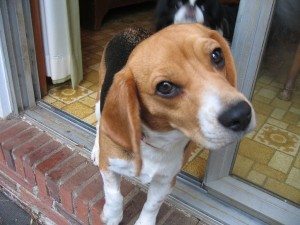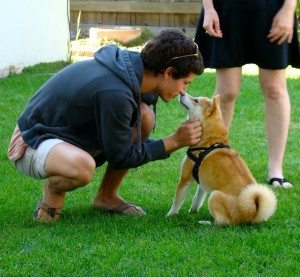 Maybe you’ve got a new puppy that you’re attempting to train not to pee or poop in the house.
Maybe you’ve got a new puppy that you’re attempting to train not to pee or poop in the house.
Or maybe you’ve acquired an older dog who has his own daily routines that aren’t coordinating very well with your own personal routines.
Either way, you can bet it will be helpful (to both you and the dog) to get into a routine that works for both of you!
You want to get your dog on some sort of a schedule so he always knows when he’s going to be allowed outside to pee & poop, when he’s going to be fed, and when he’s expected to go to sleep for the night.
Setting these types of boundaries and expectations for your dog will make housetraining so much easier.
Here’s how to get your dog to adapt to a daily routine…
How Often Do Dogs Need To Go Outside?
Generally speaking, the length of time that a dog can wait between peeing or pooping ranges from:
- 1 to 2 hours for little puppies that are brand new to your home
- 3 to 4 hours for older puppies that are familiar with the concept of going outside to pee & poop
- 8 to 10 hours for adult dogs that are fully housetrained and used to being home alone while you’re at work
Obviously, little puppies don’t know that they’re supposed to “hold it” when they’re in the house and to only pee & poop when they’re outside. You have to teach them that… from scratch.
How?
By thinking for them and guessing every single time that they might have to pee or poop. (You’ll need to do that until your dog is old enough to “tell you” when he needs to go outside.)
How To Potty Train A Young Puppy
During the first few days (or weeks) of potty training, roughly every hour or so you need to take your little puppy outside.
With treats in your hand, walk around the yard near your puppy and repeatedly use a keyword like “go outside”… “outside” (or “go potty”… “potty”). Be prepared to immediately reward your dog the moment he’s done going to the bathroom outside. At the same time, excitedly praise him with “GOOD outside! (…or “GOOD potty!”)
I learned with all 3 of my dogs that if you have treats in your hand… while you walk around the yard near your dog… and use the same word each time, then you are teaching your dog to go “on cue”. (Later, as an adult dog, you will simply have to mutter from the doorstep, “Go outside” and your dog will quickly do so — all for the joy of receiving a treat the moment he comes back in the house.)
Be sure to give your dog enough time — maybe 5 to 10 minutes each time — to figure out what he’s there to do: potty!
During these outdoor potty sessions, don’t let your dog play. Instead, walk around the yard with your dog while repeating your keyword (just like you would with any other dog command) until he pees or poops.
If after 10 minutes he hasn’t gone potty, then there are no treats given, and you should non-nonchalantly bring your dog back into the house.
One hour later, repeat the same process again. (I realize this may seem excessive but, trust me, it helps to speed up the potty training process. Personally, I’d rather spend more time each day over fewer days than less time each day over more days (or months!)… you?
The truth is, the fewer opportunities your dog has to “fail” (at holding it while inside the house), the faster your dog learns the routine.
Soon, you’ll realize your dog’s own signs that he’s about to pee or poop (at which time you will pick him up and place him outside before he even has a chance to go on the carpet). You will also notice roughly how long he tends to hold it before needing to go back outside each time.
It’s up to you to be keenly aware of your dog’s needs… and his signals. At this same time, your dog is learning what’s expected of him: to pee & poop outdoors.
By the way, I highly recommend introducing your dog to a crate. It will significantly reduce the amount of time you have to spend potty training your dog!
How To Get Your Dog Used To A Schedule
 Okay, so that was Puppy Potty Training 101.
Okay, so that was Puppy Potty Training 101.
Now, let’s talk about how to get your dog get used to a daily routine.
The following times are when you should take your dog outside each day.
These are the 5 simple steps that should be followed during each potty training trip outside:
- With treats in your hand, walk around the yard near your dog and repeatedly say your keyword (as a command) to your dog.
- Don’t rush him. Give him 5 to 10 minutes to get comfortable enough to pee or poop outside.
- Be prepared to immediately reward your dog the moment he’s done going to the bathroom outside. At the same time, excitedly praise him for a job well done.
- As long as the experience was a positive one, your dog will want to do this again! He will eventually put 2 + 2 together and realize that he gets treats every single time he pees or poops outside. This will encourage your dog to go quicker each time… on command.
- If your dog didn’t go potty outside, then walk him back inside the house without any treats or excitement this time.
An example of a daily dog routine that works:
The first thing each morning (even before you do whatever it is you normally do in the morning), your dog must get your first attention.
That’s right, when you’re housetraining, your dog gets priority above all other things!
That means your dog gets to go outside right away.
Otherwise, if he sees you moving around and doing other things, he will think that you’ve just forgotten about him. So he will have to take matters into his own hands paws and pee in the house. Dogs can’t help it — especially puppies and dogs that haven’t figured out the routine yet.
So don’t do anything that could confuse your dog. Make it clear that he is your #1 priority and that you are going to help him get outside quickly to use the bathroom.
This early morning trip outside is the start of a routine that your dog can get used to. In fact, he will come to expect it. Don’t let your dog down. Eventually, your dog will learn “Oh good, I know I’m gonna get to go outside now!” He will come to rely on you… and the routine.
Chances are, you won’t have to wait long for your dog to use the bathroom during this morning trip outside — which makes it the easiest and most effective potty training session of them all. Plus, it’s your dog’s first opportunity to “connect” with you at the start of a new day. So you can put all previous “accidents” and confusing training sessions behind you now.
Both you and your dog on are the exact same page from this point forward.
Be sure to reward your puppy with lots of praise and dog treats every single time he pees or poops outside. It makes him want to do more of that in the future!
Feed your dog at the same time each day, then let your dog outside within 5 to 10 minutes of when he stops eating.
Keep in mind, little puppies should typically be fed 2 to 3 times a day:
- Breakfast (an hour or so after the morning outing)
- Lunch (optional – because not everyone is home during the day to oversee this feeding)
- Dinner (at least 2 hours before bedtime)
Then, always within 5 to 10 minutes after your dog has eaten, he should be let outside to potty.
Follow the 5 simple steps mentioned above.
Right before you leave the house (for work, school, shopping, etc.), always take your dog outside first.
Your dog will get used to going outside before you leave him home alone.
Follow the 5 simple steps mentioned above.
The moment you return home (even if you were only gone for 10 or 20 minutes), always take your dog outside.
Remember, you’re trying to get your dog used to a routine. So it’s not about how long you were gone, it’s about you being gone… and then returning.
Your dog needs to know that every single time you return home, he gets to go outside to use the bathroom.
TIP: During the potty training process, it helps to leave the house for several short periods of time. Then immediately let your dog outside each time you return. This will teach your dog that it’s worth waiting until you return to go outside — because he gets lots of praise and lots of treats whenever he pees or poops outside.
Follow the 5 simple steps mentioned above.
If someone comes to your house, you or another family member should let your dog out immediately.
Otherwise, the excitement of the moment is likely to cause an accident on the carpet. This is especially true with younger puppies.
Follow the 5 simple steps mentioned above.
If your dog has had a lot of water to drink, immediately take him outside.
For this one, you will have to keep an eye on your dog’s activity level (and his water dish) at all times.
If you notice your dog licking his lips — like he’s just been slurping water from dish — then you need to get him outside to potty rather quickly.
Likewise, if your dog has been playing for a long time with you or with another dog, then he will probably become thirsty and drink a lot of water afterwards. Then, he will need to go outside to use the bathroom.
Follow the 5 simple steps mentioned above.
Any time throughout the day that your dog just stops and looks at you, treat it as a sign that he has to go outside.
Your dog is definitely trying to tell you something. It might be: “Can we play?” or “I need more water.” or “Can I have some food?”… But it’s in your best interest to use this opportunity to teach your dog that this is how he tells you that he needs to go outside!
So, ask your dog, “Do you need to go outside?” (or use whatever your word is).
Chances are, he will become excited simply because he’s gotten your attention. He will also follow you anywhere at this moment.
So lead him toward the door and let him outside.
Follow the 5 simple steps mentioned above.
If your dog goes to the bathroom, then give yourself a big pat on the back because you’ve just made a huge step forward in the housetraining process! You see, making the connection between your dog signaling you and you actually taking him outdoors is a win-win for both of you. This moment becomes permanently ingrained in your memory, as well as your dog’s memory!
Eventually, your dog will learn to come and “tell you” when he needs to go outside — as long as you use the same word each time, actually take them out each time, and give them a treat each time (if he peed or pooped).
Within 10 minutes of turning out the lights and going to bed for the night, take your dog outside one last time.
For consistency purposes, your bedtime should always be your dog’s bedtime. That means:
- No roaming around from room to room.
- No playing with toys.
- No opportunities to pee or poop inside the house.
This is important if you want your dog to get used to a routine.
Follow the 5 simple steps mentioned above.
Final Thoughts…
Of course, you can add as many other trips outside for your dog to potty as you want throughout each day. (The more, the merrier — because your dog will have fewer opportunities to fail that way and his chances of peeing on the carpet will be significantly reduced.)
IMPORTANT: While there should definitely be several times throughout the day when your dog is allowed to play freely or with toys outside, the above times should all be “business-related”. No playing allowed. Think of the potty training sessions as times when your dog is in school. He is learning to go to the bathroom — on command and outside.
And finally, it’s important to realize that — as much as it might seem like it — dogs don’t do things out of spite. Here’s a good way to think of it:
Behaviorists tend to believe that dogs “think” in their own way — in sensory images involving their finely honed instincts. They’re not capable of deviousness or spite. They love routine: nothing seems to make them more comfortable than doing the same thing at the same time in the family way, day after day — we snack here, we poop there, we play over here. I am astonished at how little it takes to please them, how simply their lives can be if we don’t complicate them with an overlay of human motivation. ~Katz on Dogs
Dogs do “bad” things when they’re anxious, nervous, or frightened. (Tearing up the house, raiding trash cans, etc.) Nothing more. Nothing less. They simply don’t have the thought processes required to “act out of spite” or “plot to do something”. ~Katz on Dogs




